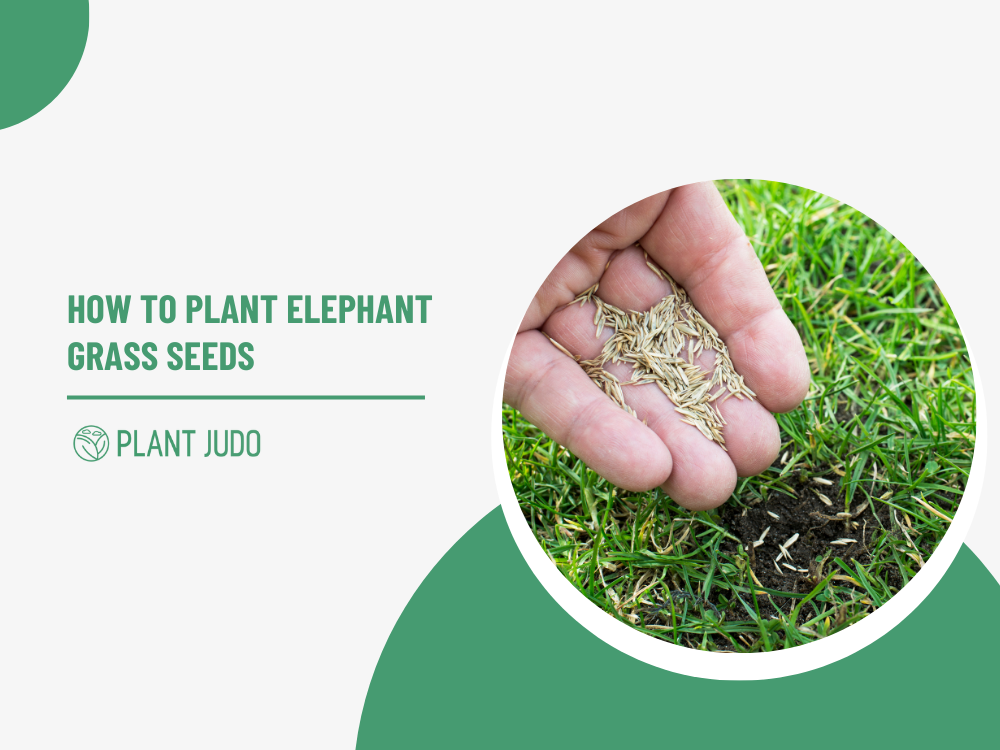The nickname Elephant grass got the grass, as it is one of the favorite grasses of elephants. It is a rhizomatous plant sometimes referred to as Napier grass or elephant grass, maybe because of its vast size.
Rhizome root systems of this grass allow it to spread extensively and become invasive. Thus it should be avoided. It is widely used as a livestock feed crop, and it is also effective at keeping pest insects away from essential food crops such as maize.
On the other hand, Elephant grass is a low-maintenance plant that thrives in moist conditions. As a result, it adds a touch of African flair to colder climates such as Germany. Consequently, because it is so simple to produce more than just grass, many people use Elephant grass to feed their cattle herds.

To plant and cultivate elephant grass plants, there are several methods available. They can be propagated from cuttings or root slips, for example. Also, many people who have a large portion of land like to plant this Elephant plant to get the business opportunity.
But today, in this article, we will show you how you can plant Elephant Grass Plant from seeds in easy ways. So without wasting any time, let’s get started.
How To Plant Elephant Grass Seeds: Step By Step Guide
Now let’s get down with our main event and learn how to plant Elephant Grass Seeds. Now try to follow our instructions and advice step by step-
Step 1: Germinate The Seeds Properly
Autumn and spring are the best seasons for growing Elephant Grass. Even though grass can be sown all year, it grows more quickly in the spring when it is in tiny plants.
Paper towels, filter paper, and even newspaper are great germination mediums for seeds. They are pathogen-free, and they make it simple to regulate the moisture content of the soil to ensure optimum germination. However, before planting the seeds in the soil, soak each one in a paper towel for at least one night.
Once you’ve soaked the seeds, take your decent soil; make sure you fill the container up to the aisle 3/4 by packing down, if not up to the surface. You can either plant the seeds straight in the ground or plant them in a container.
However, you must use finger pressure because you do not want to compress the dirt so tightly that you cannot form holes to plant your seeds. If the seed is about 1/8 inch thick, you should plant it at least 1/8 inch to a quarter-inch deep, making sure to plant all of the tiny seeds down and lay them on their sides simply.
They will write themselves as soon as they begin to germinate, which should take between 7 and 10 days. During this time, keep them moist and make sure they receive adequate moisture and sunlight so that the germination process may begin.
Step 2: Select Right Place And Transplant The Germinated Seeds
Keep a watch on the seedlings, and keep in mind that the plants can grow up to three meters in height, so they will require a lot of areas. Elephant grass should be planted in your yard, where it will receive at least six hours of direct sunlight per day.
Elephant ears can be grown in either full sun or partial shade; however, full sun is not recommended for most because they thrive in bright but indirect sunshine. Too much sunshine can cause the leaves to burn, whilst too little sunlight can lead the leaves to yellow. As a result, make sure they have access to some shade during the middle of the day.
Now it’s time to transplant them, so remove the germinated plant from the container. In the soil, create a planting hole with the same depth as the Elephant grass container and twice as wide as the Elephant grass container.
After logging, add 2 to 3 inches of compost to the bottom of the hole to boost the soil’s fertility and trainability. After you’ve finished, place the plant’s rootball in the center of the hole and push the soil around it to completely fill in the hole with soil.
Step 3: Water Properly After Transplanting Them
Water your transplants heavily immediately after placing them in their final locations in your garden. Ensure that their roots contact the soil into which they have just been transplanted.
Also, ensure that their roots contact the soil from which they have just been transplanted. 1 inch of water should be used to water Elephant grass once it has been planted.
If you need to transplant, make sure to keep the soil bed moist, never letting it dry out. To get correctly established, the plants must frequently be watered enough (typically once a day) so that the soil surface never dries up and is constantly moist.
It is essential to keep the roots and the soil as cool and moist as possible for them to successfully establish themselves in their new soil.
However, do not over-water your Elephant Plant since, to put it another way, over-watering causes your plant to drown. Roots can’t breathe in constantly damp soil because there are not enough air spaces. Stressed roots are those that are unable to breathe.
Caring Tips Of Elephant Grass
To keep your Elephant Grass healthy after planting them, you have to regularly some caring tips. Continue reading for advice on caring for your plant that will help you achieve success.
Ensure Soil Quality
The elephant grass requires loose, well-drained soil to avoid waterlogging and rot. Add some compost to the mix as a nutrient, and the elephant grass will grow to its maximum potential.
Composted soil improves plant growth by balancing soil density, and this balance allows plants to produce better roots in the soil, which contributes to improved plant growth. Established plants have a deep root system and can handle a pH level ranging from 4.5 to 8.2, but the soil pH should be between 5.2 and 8.7 to ensure optimum performance.
In contrast, all Elephant Grass plants are considered robust feeders, necessitating rich, fertile, somewhat acidic soil to thrive. Treat your plants with a slow-release, water-soluble fertilizer such as 20-20-20 or a similar product every month.
Water Properly
After planting the elephant grass, water it thoroughly to saturate the soil to around 6 inches. Maintain an even moisture level in the soil, but avoid allowing it to get saturated by applying water two to three times per week while the roots form in the newly transplanted area.
Pouring and Mulching
Probably the most typical task you perform with your potted plants is watering them, which you most likely accomplish by pouring water onto the surface of the potting soil. Watering your Elephant Grass from the bottom solves these issues and allows for more effective moisture delivery to the soil.
On the other hand, Elene is Elephant grass, a plant that serves various functions. It can be used to make mulch and help prevent soil erosion from occurring.
Trim Your Elephant Grass
Snow or ice-encrusted Elephant grasses can be quite stunning when they are in bloom. Once your warm-season grasses have turned brown, you can cut them back almost. If you decide to wait until spring to trim your trees, cut them back to the ground (you can leave a few inches to allow for new growth) by late spring before new growth starts. Brown spots should be removed regularly instead of this trimming.
Tree trimming removes dead and dying branches and stubs from your trees, making room for new growth and preventing damage to your property and passing cars. It also serves to keep pests and animals away from the plant and encourage the plant’s natural structure and healthy growth.
Prevent Pest And Diseases
Although Elephant grass is naturally resistant to pests and diseases, it is nonetheless susceptible to attack by pests and diseases. Waterlogging is one of the most significant factors contributing to their vulnerability to sickness.
It’s important to remember that too much water might be harmful to the plant while watering because pests prefer to spread in moist environments. To avoid continuously damp leaves, avoid overhead watering and over-watering your Elephant Grass plant.
In addition, spray your elephant grass plants with pests remover liquid once they have reached the age of four weeks. Spray them once a week during rainy weather and twice a week during dry weather.
FAQ
What kills elephant grass?
While a frost will kill the plant above ground, freezing soils are required to kill the plant’s rhizome system. The cultivation of Napier grass can actually facilitate the spread of the grass. Chemically, it can be controlled by using a 2 percent glyphosate solution mixed with a surfactant and ammonium sulfate and spraying it on the lawn.
Can Rabbits eat elephant grass?
Rabbits consume a wide variety of grasses, including guinea grass, elephant grass, maize, and millet leaves.
Why do farmers grow elephant grass?
Answer: An elephant grass crop is a high-yielding energy crop that grows over 3 meters tall, compared to bamboo, and yields a crop year after year without replanting. Elephant grass is native to Africa and grows over 3 meters tall, resembles bamboo, and yields a crop year after year without replanting. It is primarily utilized for feedstock production for energy and non-energy end purposes, with some use for other end uses.
Final Thought
These are the methods for sowing Elephant Grass Seeds.
Elephant grass is often grown as a windbreak and as a firebreak. Additionally, it is used to increase the soil’s fertility and reduce erosion.
If you have any comments or questions concerning this article, please leave them in the comment area below. We will make every effort to respond to you as quickly as possible.
Good Luck!!


